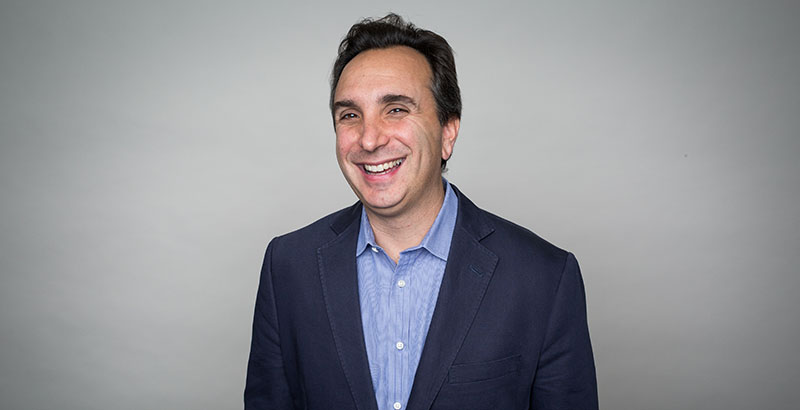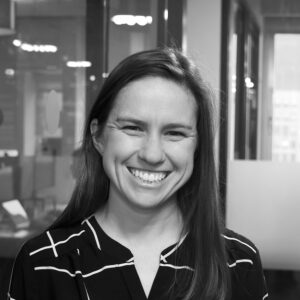74 Interview: Joel Rose on Personalized Learning’s ‘Overdue Transition,’ Building Better Tests — and Meeting Kids Where They Are

See previous 74 interviews, including 2017 Teacher of the Year Sydney Chaffee, former education secretary John King, and former secretary of state Condoleezza Rice. The full archive is here.
Personalized learning will dominate the 2018 education conversation in deeper and more meaningful ways, predicts one of its earliest adopters.
This year, there will likely be “widespread recognition” of both the need to tailor learning to individual students’ strengths and needs and the shortcomings of current testing practices, said Joel Rose, co-founder and CEO of New Classrooms, a nonprofit that offers a personalized learning platform for middle and high school math students called Teach to One.
Teach to One: Math is currently reaching about 10,000 students in 37 schools and recently expanded into high school classrooms. Greater reach will come, Rose said, but New Classrooms’ immediate goals aren’t based on encompassing more kids, but rather on using data to increase the impact of personalized learning and sharing the data with other K-12 educators and organizations.
Rose talked with The 74 in December about “the long-overdue transition” to personalized learning strategies in American schools, where he expects to see change in 2018, and the role he wants New Classrooms to play in creating a “more rational system” that’s “not prioritizing knowing how far behind [students] are over giving them an experience that can potentially do something about it.”
This interview has been lightly edited for length and clarity.
T74: How did being a classroom teacher start you on this path to personalized learning?
Rose: When I taught … I remember my principal gave me these papers that showed me the incoming grade levels of the kids in my class — and I taught fifth grade, and some were at a second-grade level, some were at an eighth-grade level, and everything in between. And then he gave me a set of fifth-grade textbooks, and he said, “Good luck.” And I tried as best as I could, but there was no possible way I could possibly meet the needs of every student every day when I was a teacher. I don’t think any teacher truly can.
You’ve talked about combining approaches in education, bringing together things like personalized learning, social-emotional learning, and competency-based learning and assessment. What does bringing all of that together look like in real life, in the classroom?
So I think there are some really important conversations happening now around competency-based learning, personalized learning, social-emotional learning, but the idea that the teacher will go to the training to learn how to do any of them and then just bring them back to their classroom and do them is just not going to happen. The burden of really integrating much of what we know in those domains into the classroom experience just can’t fall squarely on the backs of teachers. And so what I think we’ll begin to see more of are what we call holistic learning models that are designed in ways to embed these principles — and other principles — in ways that individual teachers or schools can customize to their unique needs.
What challenges do you anticipate personalized learning is going to face in 2018?
I think there are a couple. One is everyone has different definitions of what is meant by personalized learning. And so it will be painted with this broad brush including everything from using an app in a classroom to the type of work that we do [at Teach to One], and in ways that aren’t really helpful to advancing the conversation.
I think the second challenge that we see is that we have an assessment and accountability regimen that’s focused on grade-level standards, and personalized learning is really about meeting kids where they are and enabling them to accelerate. Given so many kids are coming into middle and high school one, two, three, four years behind, it can be tricky for anyone to both meet them where they are, enable them to succeed, as well as prepare them for grade-level content all in one school year.
What changes do we need to make in how we assess students?
I think, for one, we need to look at more adaptive assessments that can truly measure growth from where kids come in to when kids leave, and where many states and districts claim to be focused on growth, they sometimes forget that if the underlying assessments only include grade-level content, they’re unable to tease out growth on pre- or post-grade scales.
The second thing I think we’re going to need to look at is, what can competency-based assessment truly look like? So, for example, if Johnny walks into fifth grade one day and we say, “There are 304 mathematical skills and concepts you’re going to need to be ready for high school. We’ll be with you every step of the way. It might take you three years, it might take you five,” we need to have an assessment accountability system that is oriented around what’s best for Johnny and a system that incentivizes and gives teachers the ability to truly meet him where he is.
How will making those changes help students?
The fact of the matter is that when teachers teach grade-level content in math to students who are three and four years behind, it is, one, a waste of precious instructional time; two, has significant social and emotional implications for the student, who feels like a failure day in and day out; and three, must be having job-satisfaction implications for the teacher, who themselves feel like a failure every single day. So we’ve got to figure out what a more rational system would be so that we’re really doing right by the kid and not prioritizing knowing how far behind they are over giving them an experience that can potentially do something about it.
Have you seen seen any assessments yet that are there or close to there in measuring some of these things and not only focusing on that grade-level metric?
One assessment like that is NWEA MAP [Northwest Evaluation Association Measures of Academic Progress]. Interestingly, Chicago’s been using the MAP for several years, and they happen to be the fastest-growing school district in terms of performance on NAEP [National Assessment of Educational Progress]. And so one theory is perhaps because their teacher accountability is aligned to MAP as opposed to the state grade-level assessment, it is giving their teachers more permission effectively to truly meet their kids where they are. …
There are some imperfections with MAP as well, but it is a much better instrument at teasing out gains on pre- and post-grade scales than our grade-level assessments that only test grade-level content.
Have you seen any states using the flexibility allowed by the Every Student Succeeds Act to adopt competency-based testing models?
ESSA does give states and districts some flexibility in terms of, certainly, their accountability systems, and there’s permission for states to explore with innovative assessments, but the law is written to suggest that those innovative assessments must incorporate grade-level content at a minimum. They can do additional testing beyond that, but the grade-level content seems to be the non-negotiable. And so whether that’s enough flexibility to get to the type of assessments that we think kids truly need is a bit more of an open question.
How do you respond to criticisms of personalized learning approaches?
Some of the criticisms, I think, are valid. There are some models that are too focused on the use of computers, there are approaches out there that don’t in and of themselves promote deeper, more conceptual learning, and there are solutions out there where they slap on the label of personalized learning but it really isn’t that.
So some of those critiques are fair. It’s why we believe so strongly that the future will be about new learning models that are holistically designed to integrate lots of different ways kids can learn, be it with teachers, collaboratively, or independently, and that personalized pathways is just one tenet of how those models are designed.
I’ll say that a slightly different way as well — I know that sounded really sort of wonkish:
Giving teachers a bunch of computers and saying “Go do personalized learning” isn’t really personalized learning; it’s a tool in that situation. When you can actually take the time to reimagine experience, the whole student experience, to meet students where they are, in all the different ways that they can learn, that’s when personalized learning will truly take off.
Right now Teach to One is reaching about 10,000 students and 37 schools and has expanded into some high schools. What are the expansion goals moving forward, and specifically for 2018?
While I know we will expand, our near-term priorities are kind of focused on using the data we gather each day to drive results. We are learning about learning, which experiences work best for students, the order in which students experience different skills and concepts, and so while there will come a time when scale becomes our primary objective, right now we really are focused on driving impact.
How does Teach to One do that [meet kids where they are]?
The way our model works is we take the data from when students come in on the first day, be it fifth grade or ninth grade. With that data, we create what’s effectively a personalized curriculum that is a reflection of skills they don’t yet know and will be ready to learn. In some cases, that includes pre-grade skills, on-grade skills, or post-grade skills. The goal is to accelerate students as best we can by meeting them where they are.
Anything else on your mind going into 2018?
On the R&D side, the key to high-quality holistic models is the R&D that goes into the design of those models. We’re now over five years just to the middle of high school and just in math, hundreds of thousands of people hours that have gone into it, and we’re now beginning to use the data that we’ve gathered over the last three years … to truly understand the benefits of meeting students where they are and the drawbacks of teaching them skills and concepts they’re not ready for or already know.
And so I think in the coming year, we’ll look forward to sharing more about what we’re learning with the broader K-12 community because in many cases that may inform their strategies of how best to support their students.
What does that sharing look like?
I expect we’ll be publishing more pieces, we’ll be holding more webinars, we’ll be putting more information on our website, so that as we sort of glean what the data is telling us, we can make sure that others have the benefit of that as well.
Is that something that’s important to you, not just that you’re getting people to sign up for Teach to One but sharing what you’ve learned from it?
Very much so. For us, this is about trying to facilitate a transition away from the factory-model classroom into one that is more personalized and one that meets the needs of each student. Whether that means we’re the ones doing it or others are doing it, we really don’t care all that much. What we’re really trying to do is help to facilitate this long-overdue transition.
Get stories like these delivered straight to your inbox. Sign up for The 74 Newsletter

;)
